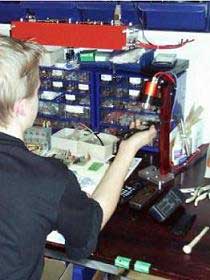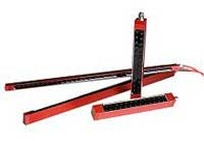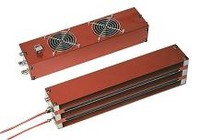Antistatic, static electricity, dust and particle problems
Main menu:
Dust in electroptics
Support / Links - PDF > Applications_list
![]() Dust in Electrooptics
Dust in Electrooptics ![]()
It is common knowledge that static electricity is a serious problem in the electronics industry and one tries to build ESD-safe environments. Another huge problem is all the dust and unwanted particles which are attracted to optics, electronics and other details. Most of us have probably experienced the difficulty of keeping the TV screen dust free - it does not matter how carefully you wipe the screen is still attracts dust. The components or products handled are often to a large extent made of insulators (materials which can be electrostatically charged) e.g. plastic in covers, glass in display windows or lenses, PC-board laminate, protective films and foils etc. Unwanted particles are to large extent electrostatically charged which makes the problem worse. Attempts to wipe clean the items or to use compressed air cleaning often causes more damage since the included friction generates more charge buildup.
Solution
With an appropriate installation of antistatic equipment both the discharging of surfaces and the removal of unwanted particles can be achieved. By using ionizing equipment one can easily discharge the surfaces and eliminate the electrostatic attractive forces acting between surface and particle. The removal of dust and particles will then be straight forward.
In some cases it is necessary to avoid a charge buildup which is generated on moving conveyor belts, while removing protective films/foils etc. Discharging the details is made as a preventive measure, in order to avoid that the charged buildup of the details would attract unwanted particles. For this purpose, applications with basic single row antistatic bars to fans or other blowing equipment could be suitable. When dust and particles already have stuck to the surface one need to use some type of blowing ionizing equipment to except for discharging also be means of an air flow by able to loosen the particles from the surface and carry them from the surface. In difficult cases it may necessary to integrate the blow cleaning with vacuuming.
Discharging
By using antistatic bars of series of ABAC or ionizing fans IFAC11 or IAFC21 efficient ways to discharge also complicated products can be found. The unique facts concerning the applications studied will help determining the equipment best suited.
Air blow cleaning
When a surface has attracted dust or foreign matter it can often be blow cleaned by use of an air blowing antistatic equipment such as an antistatic gun, ionized air nozzle or blowing antistatic bar. The ionized air discharges both surface and particles and the applied air loosens and transport the particles off the surface. Equipment is chosen to fit the application e.g. a fixed installation on a conveyor, a bench mounted equipment activated via foot valve or sensor or manually with an ionized gun.  Vacuum Extraction
Vacuum Extraction
It is often necessary to combine discharging and air blow cleaning with vacuum extraction to avoid that air borne particles further contaminate the product. Here we use an integrated system where discharging, air blow cleaning and vacuum extraction is made in a specially designed extrusion or handlheld vacuum brush.
A typical application for this can be in transporting printed circuit boards into machines for printing or before mounting in pick and place machines.



